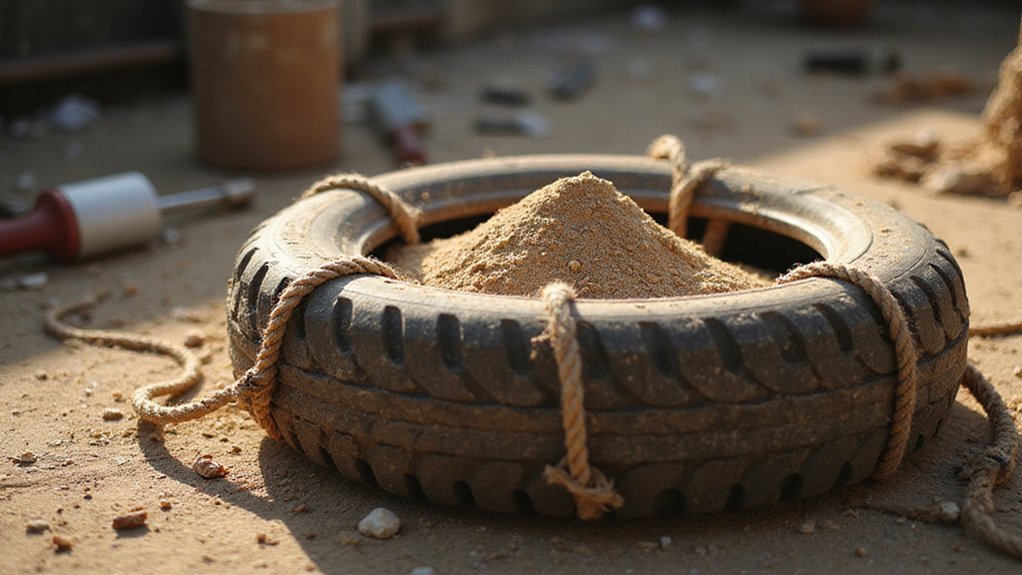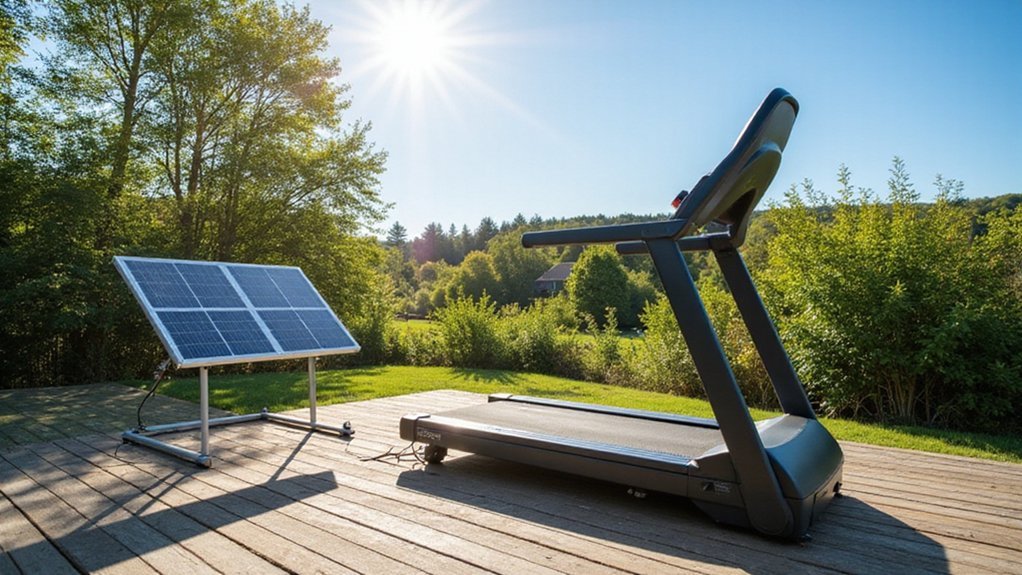Disclaimer: This content is for informational purposes only and does not replace professional medical advice, diagnosis, or treatment. Always consult a qualified healthcare provider before beginning any new exercise program.
Have you ever wondered how to transform sibling rivalry into sibling solidarity? Relay races offer a dynamic solution that turns competitive energy into collaborative fun. You’ll discover an engaging way to help siblings bond, exercise, and create lasting memories together. By designing strategic, age-appropriate challenges, you can help your children burn calories while strengthening their relationship. Curious about how these races can revolutionize family fitness and connection? Keep exploring to reveal the secrets of transformative sibling teamwork.
Key Takeaways
- Design age-appropriate relay races that match siblings’ physical abilities and developmental stages, ensuring fair and enjoyable competition.
- Implement clear, supportive rules that emphasize teamwork and mutual encouragement, preventing competitive tension from damaging sibling relationships.
- Choose activities that focus on collaboration rather than individual performance, creating opportunities for shared achievement and positive interaction.
- Establish a reward system that celebrates effort and personal improvement instead of solely highlighting winning, fostering a supportive environment.
- Prioritize safety through proper equipment, hydration breaks, and supervised play, allowing siblings to enjoy physical challenges without unnecessary risks.
Setting Up the Perfect Sibling Relay Race

While planning a sibling relay race might seem challenging, creating an engaging and safe event is easier than you’d think. Start by choosing an open area where young children can move freely without risk of collision. Consider your siblings’ ages and abilities when forming teams, ensuring everyone can participate comfortably and enjoy the physical activity.
Design a course that incorporates varied movements like running, hopping, or balancing objects to keep the race exciting and dynamic. Add playful obstacles that challenge participants while maintaining safety. Establish clear, simple rules that promote fair play and teamwork, transforming the relay race into an opportunity for siblings to bond, compete, and have fun together.
Essential Race Variations for Different Ages
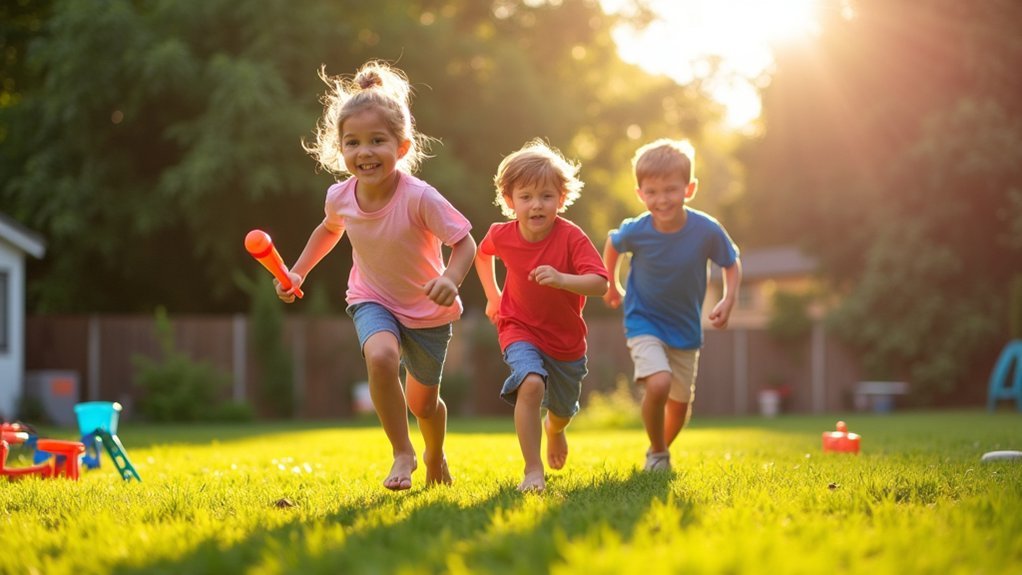
Because sibling relay races can spark joy and promote healthy competition, tailoring the race format to each age group guarantees maximum engagement and fun. For younger kids (4-7), create short, playful routes that include hopping or skipping to maintain their interest in age-appropriate activities. Middle-aged children (8-12) will thrive with team-based challenges that develop motor skills and teamwork strategies, incorporating obstacle elements that make participation exciting. Teenagers (13-18) respond best to more competitive formats, such as timed races or sports-themed relays that elevate physical intensity and build camaraderie. The key is adapting race designs to match each child’s developmental stage, ensuring everyone feels challenged yet capable. By varying activities and adjusting difficulty levels, you’ll create an inclusive experience that keeps all siblings motivated and actively participating.
Safety Tips and Equipment Recommendations
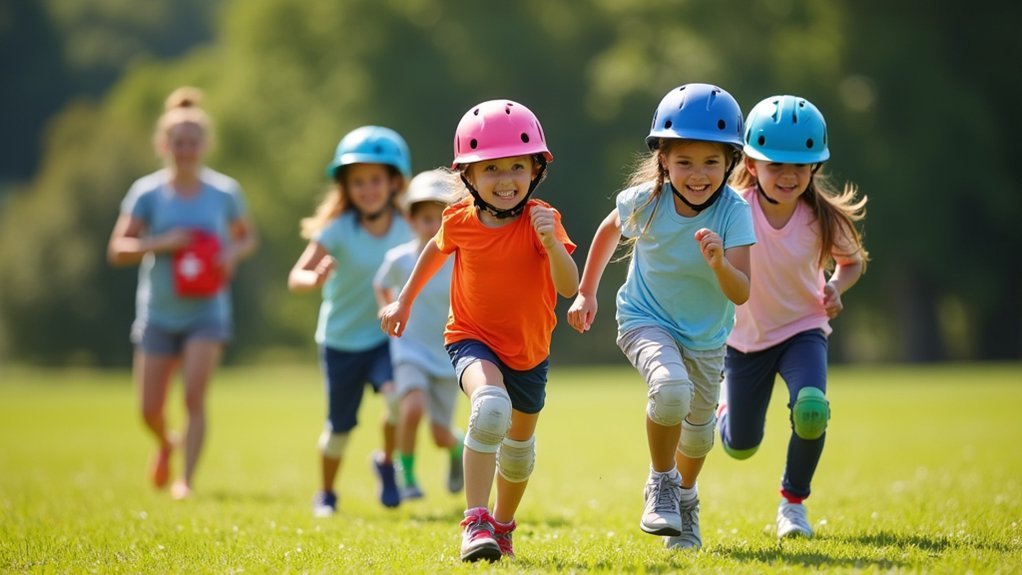
When planning sibling relay races, safety should be your top priority to guarantee an enjoyable and injury-free experience. Start by selecting safety equipment that protects your children during the activity. Choose running shoes with good traction to prevent slips and secure stable movement. Opt for a spacious, obstacle-free area that minimizes collision risks and provides ample racing space.
Implement footwear guidelines that require closed-toe, supportive athletic shoes for all participants. Consider using lightweight batons or soft objects for handoffs to reduce potential injury. Establish clear race rules that promote fair play and healthy sibling interactions.
Develop hydration strategies by scheduling regular water breaks and monitoring participants for signs of fatigue. Watch for overheating, especially during warm weather, to keep the race fun and safe for everyone.
Building Strong Family Bonds Through Competition

Sibling relay races transform ordinary family time into powerful bonding experiences that forge lasting connections through friendly competition. You’ll discover that these dynamic activities aren’t just about winning, but about strengthening teamwork dynamics between siblings. By engaging in competitive challenges, you’re creating opportunities for enhanced sibling communication and mutual support.
The competitive spirit becomes a catalyst for deeper relationships, encouraging each family member to cheer, strategize, and collaborate. When you race side by side, you’re building more than physical endurance—you’re constructing emotional resilience and trust. These shared experiences reduce feelings of isolation and create a supportive family environment where siblings learn to motivate and rely on each other, turning physical activity into a powerful tool for emotional connection and personal growth.
Tracking Progress and Maintaining Motivation
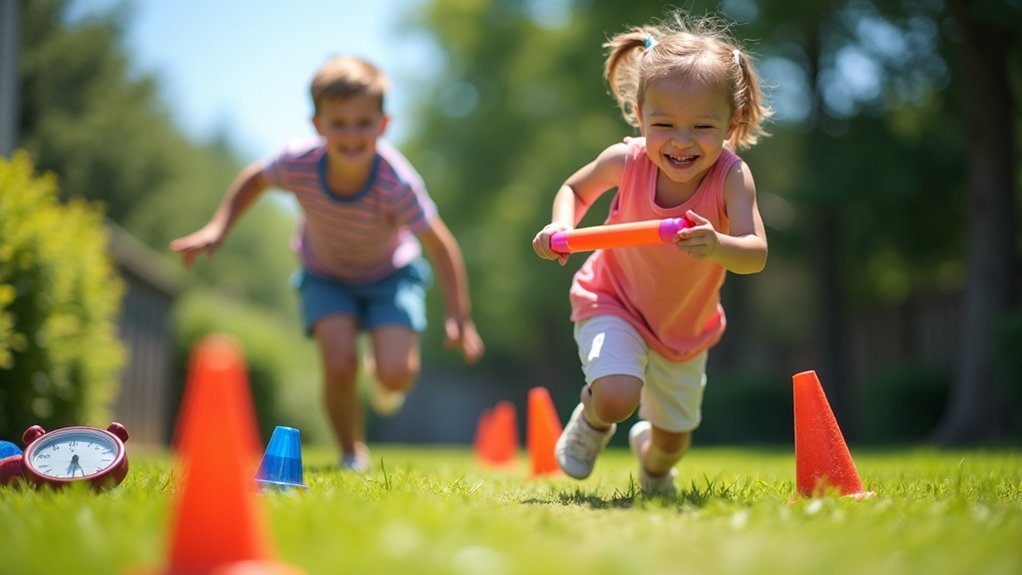
While competitive spirit drives initial enthusiasm, sustained engagement in sibling relay races requires strategic progress tracking and consistent motivation. You’ll want to leverage progress tracking methods like timers and mobile fitness apps to visualize your achievements and set measurable goals. By creating an accountability partnership with your sibling, you can transform your races into an exciting journey of mutual improvement.
Motivation enhancement techniques can keep the energy high: consider implementing a reward system with small prizes for personal bests or establishing friendly challenges that spark playful rivalry. Regularly checking in on each other’s progress and celebrating milestones will not only strengthen your sibling bond but also fuel your collective determination to push physical boundaries and enjoy the shared experience of relay racing.
Frequently Asked Questions
Is Competition Between Siblings Healthy?
You’ll find that sibling bonding thrives when you embrace a healthy competitive spirit. Respectful rivalry can motivate growth, strengthen connections, and teach valuable life skills without damaging your relationship’s foundation.
How Does Sibling Rivalry Affect Relationships?
You’ll find that sibling rivalry can strain relationships, but understanding its dynamics helps you build stronger bonds. By recognizing competitive patterns and choosing cooperation, you’ll transform potential conflict into meaningful connection and mutual support.
What Does an Unhealthy Sibling Relationship Look Like?
You’ll notice toxic dynamics when siblings constantly compare themselves, maintain emotional distance, and struggle to communicate supportively. These patterns create tension, erode trust, and prevent meaningful connection, leaving you feeling isolated and emotionally drained.
How Does Having a Sibling Affect Your Mental Health?
Your sibling can shape your emotional resilience through shared childhood experiences. They’ll influence your mental health positively or negatively, providing support dynamics that either strengthen or challenge your psychological well-being throughout life’s complex journey.
Conclusion
Ready to transform sibling rivalry into sibling revelry? Relay races aren’t just about winning—they’re about connecting. By embracing these playful challenges, you’ll strengthen family bonds, boost fitness, and create memories that’ll last generations. Don’t just compete; celebrate each other’s strengths. Your family’s energy, laughter, and teamwork will turn every race into a victory worth cherishing.

